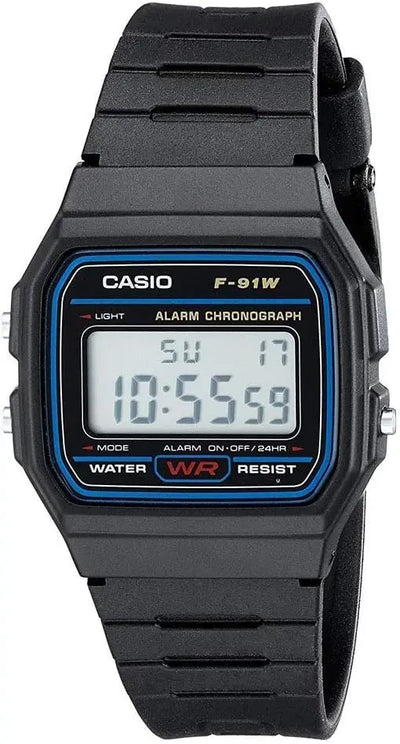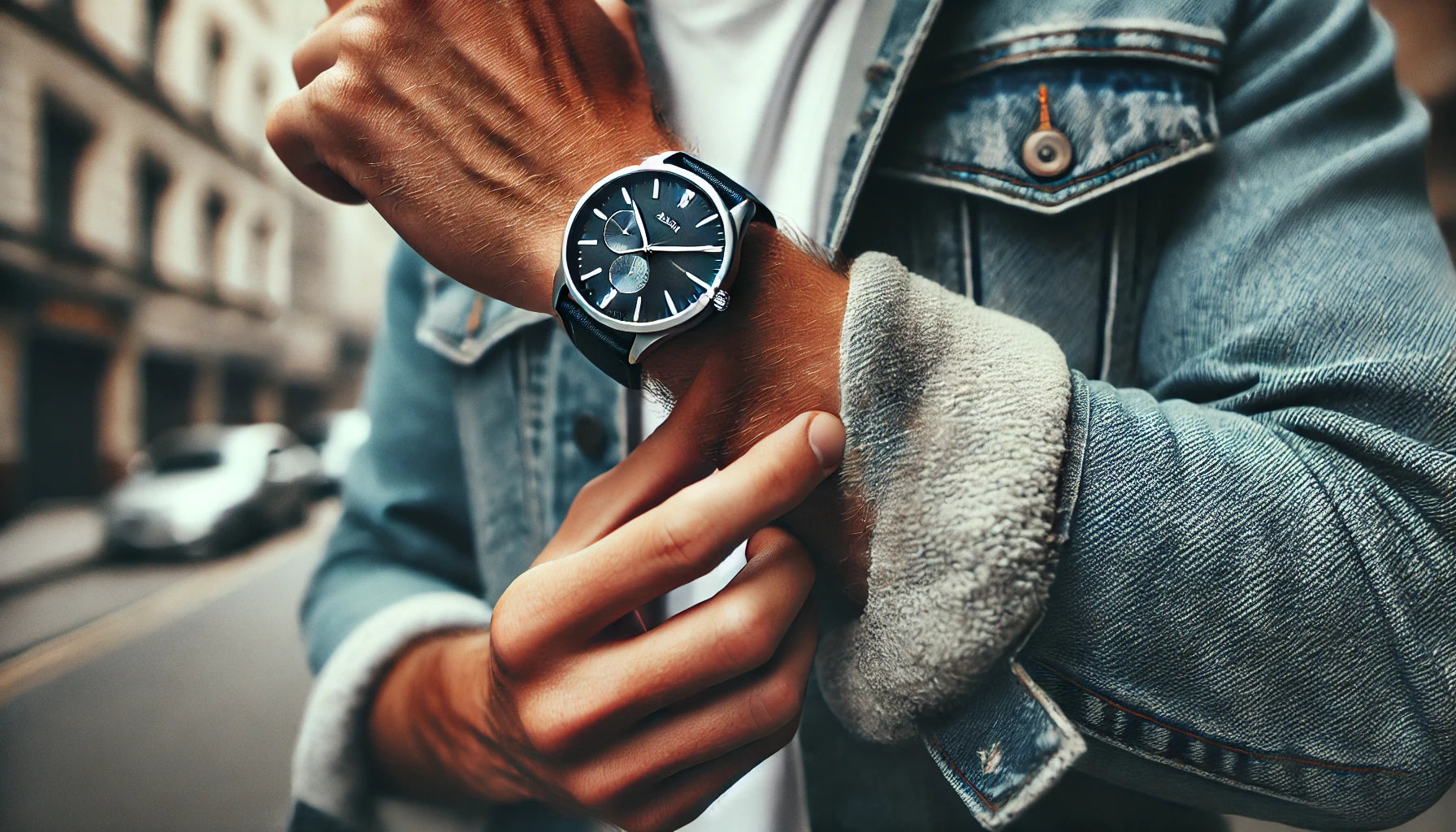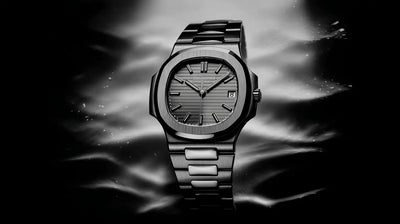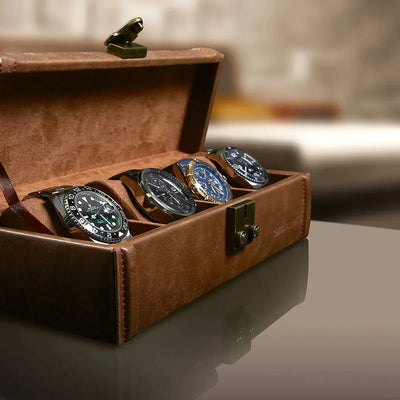
What is the best-selling watch in the world?
Which watch is the best-selling in the world among all the brands and models available on the market? We will explore...



You're probably tired of damaging the delicate surface of your watch or having unfortunate encounters with objects during your daily movements. Wearing your watch facing inward is not just a trend, it's a real strategy to protect the dial from shocks while allowing you to easily check the time without spilling your drink. Discover how this small change of style can add a touch of originality to your look while preserving your precious accessory.
Are you wondering why the watch is traditionally worn on the left wrist? Historically, it is due to the prevalence of right-handedness among the population. About 90% of people are right-handed, so it made more sense to wear the watch on the wrist that is less stressed, that is, the left .
But this choice is not just a matter of tradition. In fact, it is also very practical . If you have to handle objects, it is wiser to protect your watch by avoiding shocks that could damage it, while being careful not to drop or damage what you are holding, such as a glass, for example.
In addition to these considerations, closing your watch strap is easier when you wear it on your left wrist, especially if you are right-handed. Indeed, using your right hand to adjust the watch is much more natural. In addition, this wearing allows you to keep an eye on the time without contorting yourself. In short, wearing your watch on your left wrist remains the most logical and functional choice, offering you both style and practicality .
Offer For our readers: discover our watch boxes and benefit from a 10% reduction with the code BLOG10
By wearing your watch on the inside of your wrist, you minimize the risk of damage to the dial. This allows you to avoid collisions with surrounding objects, especially when you are moving. In this way, you protect not only your watch , but also the objects you are handling, thus preserving the integrity of both.
Another practical reason to wear your watch indoors is the ease of reading the time . This allows you to quickly glance at your watch without having to awkwardly tilt your wrist. You can simply do this while holding a drink or having social interactions, making the situation more fluid and comfortable.
Indeed, when your watch is positioned inside, it is more accessible and you avoid spilling your drinks or disturbing your activities by trying to see the time. This practical aspect is particularly relevant in social situations where discretion is required. In the hustle and bustle of everyday life, such convenience can only be appreciated.
Finally, some people find that wearing the watch on the inside of the wrist is stylish and different . This arrangement brings a touch of originality to your daily look. By showing off your watch in this way, you stand out from the others and assert a certain taste for elegance.
Additionally, wearing your watch indoors can create a surprising effect , drawing the attention of those around you. It reveals a bold and modernized sense of style, adding a unique dimension to your presentation. Embracing this trend can not only breathe new life into your watch collection, but also reinforce your position as a fashionable person.
When choosing your watch, it is essential to know the different types available on the market in order to find the one that best suits your style and daily needs. Here are the three main categories of watches:
| Watch Type | Features |
|---|---|
| Mechanical Watches | Operated by a spring, require regular winding. |
| Quartz Watches | Use a battery, very precise and resistant. |
| Smart Watches | Electronic devices with various connections and multiple functionalities. |
Mechanical watches are divided into two subcategories: hand-wound watches and self-winding watches. Their principle is based on a movement of gears and springs that stores and restores energy. Although they are often more expensive, they are appreciated for their aesthetics and the beauty of their mechanisms.
Quartz watches are very popular because of their simplicity and remarkable accuracy. A battery powers a quartz crystal that vibrates to keep time. This allows you to enjoy an aesthetically pleasing watch, without the hassle of winding.
These watches, although economical , have a limited lifespan because they depend on the wear of the components. You must therefore be vigilant about their maintenance, even if they are generally shock resistant. Taking care of your quartz watch ensures its functionality and will extend its life.
Smartwatches work like mini-computers, offering multiple features ranging from health tracking to notification management. Their connectivity allows you to stay connected, but they are entirely electronic , which makes them non-repairable.
It is essential to keep in mind that a smartwatch is subject to battery depletion after a few years. Recognizing that these watches can become obsolete over time could influence your choice when purchasing. You will also have to take into account the often high price compared to more traditional models.
Mechanical watches, whether hand-wound or automatic , are distinguished by the beauty of their visible mechanism and their longevity. However, their price can be high and they require regular servicing every five years. In addition, they are less resistant to shocks.
Quartz watches are a very popular choice due to their accuracy and durability . Easy to maintain, they operate using a battery. However, their lifespan is generally shorter than that of mechanical watches, and once damaged, they are often thrown away rather than repaired.
Additionally, quartz watches are generally more shock resistant and can incorporate many electronic features, such as digital displays and stopwatches. This makes them ideal for those looking for a watch that is both practical and functional. But be careful, their design relies heavily on components that can wear out quickly, making their longevity uncertain.
Smartwatches, like small portable computers , offer a multitude of features, ranging from managing your health to connectivity with your devices. However, they are entirely electronic and their battery will need to be changed every two to three years, and above all, their repairability is often questioned.
Moreover, although they are very practical and modern, their main drawback remains that they are not repairable in the event of a failure. Due to their electronic complexity, a simple failure can force you to replace them completely. It is therefore crucial to weigh the pros and cons carefully before making your choice in terms of technology.
Adjusting your watch strap is essential for optimal comfort and elegant style. An ill-fitting strap can not only be unpleasant but also detract from the overall appearance of your watch. Here is a simple method to help you adjust your strap easily and successfully.
| Stage | Description |
|---|---|
| 1 | Open the bracelet to access its links. |
| 2 | Note the direction of the arrows on the links to know where to remove this pin. |
| 3 | Position the pin punch in the appropriate location and screw it in. |
| 4 | Carefully remove the pin by hand. |
For a successful adjustment, it is helpful to follow a few practical tips. Make sure to use quality tools to avoid damaging your watch. Also, make sure to remove links evenly on each side to maintain the aesthetics of your piece. In addition to this, keep in mind that comfort is paramount.
Assume that you enjoy a well-fitting watch, as it can transform your wearing experience. Also, keep in mind that changes in temperature or conditions can affect your wrist size, so be prepared to readjust as needed.
Consider every adjustment an opportunity to add a personal touch to your style. Ultimately, a well-fitting strap not only ensures the proper functioning of your watch, but also reflects your attention to detail, which is essential for an authentic look.
It’s important to consider your wrist size when choosing a watch, as the proportion between the diameter of your wrist and the watch face influences aesthetics and comfort. Generally, a watch that’s 34mm to 40mm is best for slim wrists, while 40mm to 46mm faces work well for larger wrists. Make sure the watch sits comfortably on your wrist without being too tight or overly snug.
Your personal taste plays a major role in choosing the size of your watch. Some prefer a larger watch to make a bold statement, while others opt for more understated designs. The key is to select a watch that resonates with your style without sacrificing comfort.
Every individual has their own inclinations , and it’s perfectly normal to hesitate between a large watch and a smaller one. What matters is that you feel good about your choice. Think about your daily activities: if you’re often on the move, a lighter, less bulky watch might be more comfortable to wear. Elegance isn’t just in the size, but in the way you confidently wear your watch.
Wearing your watch on the inside of your wrist is not just a question of aesthetics, it is also a practical way to protect the dial from shocks. By opting for this style, you also allow a more discreet reading of the time, without fear of spilling your glass. You thus bring an original touch to your look while maintaining the functionality of your accessory. So, why not try this new way of wearing your watch and assert your style with class?
A: Wearing your watch on the inside of your wrist is a trend that offers both added protection for the dial and a distinctive style. Positioning the watch in this way reduces the risk of accidental impact with surrounding objects, which can extend the life of the watch. Additionally, it allows you to read the time without having to tilt your wrist or raise your arm, which can be convenient in certain situations.
A: Yes, wearing the watch on the inside of the wrist may be more comfortable for some people. It reduces the risk of the watch getting caught or bumping into objects during frequent movements. Additionally, for those who are often in contact with their surroundings, it helps minimize distractions caused by the watch bumping into other objects.
A: Absolutely. The style of the watch can influence this trend. Watches with a clean or minimalist design often look their best when worn this way. Additionally, it can give an impression of sophistication and modernity. However, it is important to choose a watch that remains functional and aesthetically pleasing even when positioned on the inside of the wrist.

Which watch is the best-selling in the world among all the brands and models available on the market? We will explore...

It leaves no trace. No scratches, no dents. Nothing visible. And yet, magnetism is one of the quietest enemies of your automatic watch. ...

The world of watch boxes offers a multitude of options to meet various needs and preferences. From a simple storage box to...
Leave a comment
This site is protected by hCaptcha and the hCaptcha Privacy Policy and Terms of Service apply.